Sanqing Mountain (三清山), located in Shangrao City, Jiangxi Province, is renowned for its stunning natural beauty and its significance in Taoism. The name “Sanqing” translates to “Three Pure Ones,” referring to the three main peaks of the mountain: Yujing Peak, Yuxu Peak, and Yuhua Peak. These peaks are so striking that they are said to resemble the Taoist deities sitting at the mountain’s summits.
The Sanqing Mountain Scenic Area covers a total area of 756.6 square kilometers, with the core scenic area spanning 230 square kilometers. The highest peak is Yujing Peak, which stands at 1,819.9 meters above sea level and is also the source of the Xinjiang River.
Sanqing Mountain features several notable scenic spots, including: Nanquanyuan (South Qing Garden), Xihai Coast (West Sea Coast), Sanqing Palace, Tiyun Ridge (Cloud Ladder Ridge), Yujing Peak, Sunshine Coast,Yuling Temple (Jade Spirit Temple), Sandongkou (Three Caves Mouth), Bingyu Cave (Ice Jade Cave), Shigu Ridge (Stone Drum Ridge).
The World Heritage Committee describes Sanqing Mountain as showcasing unique granite pillars and peaks within a relatively small area. The rich granite formations, varied vegetation, and dramatic climatic phenomena create a one-of-a-kind aesthetic effect. This combination presents an impressive natural beauty. “China National Geography” magazine has recognized Sanqing Mountain as one of “China’s Top Five Most Beautiful Peak Forests.” Additionally, geologists from China and the United States have acclaimed it as “the most beautiful granite formation on the western Pacific edge.”
Table of Contents
- Basic Information
- Location and Transportation
- Map of Sanqing Mountain
- Ten Scenic Areas in Sanqing Mountain
- Major Attractions in Sanqing Mountain
- Spectacular Natural Phenomenon
- Cultural Relics in Sanqing Mountain
- Vlog about Sanqing Mountain
- Sanqing Mountain and Taoism
- Other Iconic Attractions in Shangrao
Basic Information
| Estimated Length of Tour | 1 day |
| Ticket Price | Admission: 120 RMB One-Way Cable Car: 70 RMB Round-Way Cable Car: 125 RMB |
| Opening Hours | 7.30 – 17.30; Last admission: 17.00 |
| Telephone Number | 0086-0793-96373 0086-0793-5292373 |
Location and Transportation
Sanqing Mountain Scenic Area is located at the junction of Yushan and Dexing counties in Shangrao City, Jiangxi Province, China, near the eastern gateway to Zhejiang Province. The geographic coordinates are 28°54′N latitude and 118°03′E longitude. The nearest city to Sanqing Mountain is Yushan, approximately 50 kilometers away, connected by a dedicated tourist road. Shangrao City is an alternative transit hub. To get there, you can choose one of the following ways:
- From Yushan County:
- Train to Yushan: Take a train to Yushan and then transfer to a bus, electric tricycle, or taxi to Yushan Bus Station. Electric tricycles are common and cost around 5 RMB per person. The ride takes about 5-8 minutes.
- Bus to Sanqing Mountain: Buses to Sanqing Mountain depart from Yushan Bus Station to two destinations: the eastern Jinsha and the southern Waishuangxi. Tickets cost about 16 RMB per person. Buses run every 40 minutes, taking about an hour to reach the cable car stations. The earliest bus departs at 6:10 AM, with the latest buses at 5:00 PM for the southern route and 6:10 PM for the eastern route.
- From Shangrao City:
- Train to Shangrao: Shangrao is well-connected with various train services, including high-speed trains. However, fewer direct buses run from Shangrao to Sanqing Mountain.
- Bus to Sanqing Mountain: Buses from Shangrao to the southern cable car station depart at 7:30 AM and 1:30 PM. The bus to the eastern cable car station departs only at 5:20 PM. From Shangrao Railway Station, you can take a bus or motorcycle taxi to the national highway, then catch a bus to Yushan County. The total travel time from Shangrao to Sanqing Mountain is about 1 hour and 50 minutes.
- For late arrivals at Shangrao Railway Station, staying overnight in the city and taking a bus to Yushan the next morning is an option. Buses from Shangrao City Center to Yushan run from 6:00 AM to 6:00 PM every 15 minutes, with evening buses at 6:10 PM, 6:40 PM, 7:20 PM, and the last one at 8:00 PM.
Map of Sanqing Mountain

Ten Scenic Areas in Sanqing Mountain

Nanquanyuan Scenic Area (南清园景区)
- Location: Central Sanqing Mountain.
- Highlights: Known for its breathtaking granite peak formations created over 1.4 billion years of geological evolution. Key spots include Liuxia Terrace, Yuhuang Peak, and the scenic areas of Juming Mountain and Yuxian Valley. This area showcases some of the most unique natural landscapes of Sanqing Mountain.
Sanqing Palace Scenic Area (三清宫景区)
- Location: Mid-mountain, beneath Yujing Peak.
- Highlights: This historical area is the spiritual heart of Sanqing Mountain. It includes the ancient Taoist temple Sanqing Palace, where historical figures like Ge Hong practiced alchemy and Taoism. The site features stone carvings of Taoist deities and figures.

Yujing Peak Scenic Area (玉京峰景区)
- Location: The highest peak of Sanqing Mountain.
- Highlights: Standing at 1,819.9 meters, Yujing Peak offers panoramic views. This area includes the Nine Heavens Palace, Hongcha Flower Stone, and the stunning Flying Immortal Valley and Queen Mother Valley, with its dramatic landscapes and meteorological phenomena such as sea of clouds and sunrise.
West Sea Coast Scenic Area (西海岸景区)
- Location: Western Sanqing Mountain.
- Highlights: This area provides expansive views and features the highest and longest mountain plank road in China. It traces the former coastline of the area, offering a 4-kilometer scenic walk with smooth paths and impressive cliffside vistas.
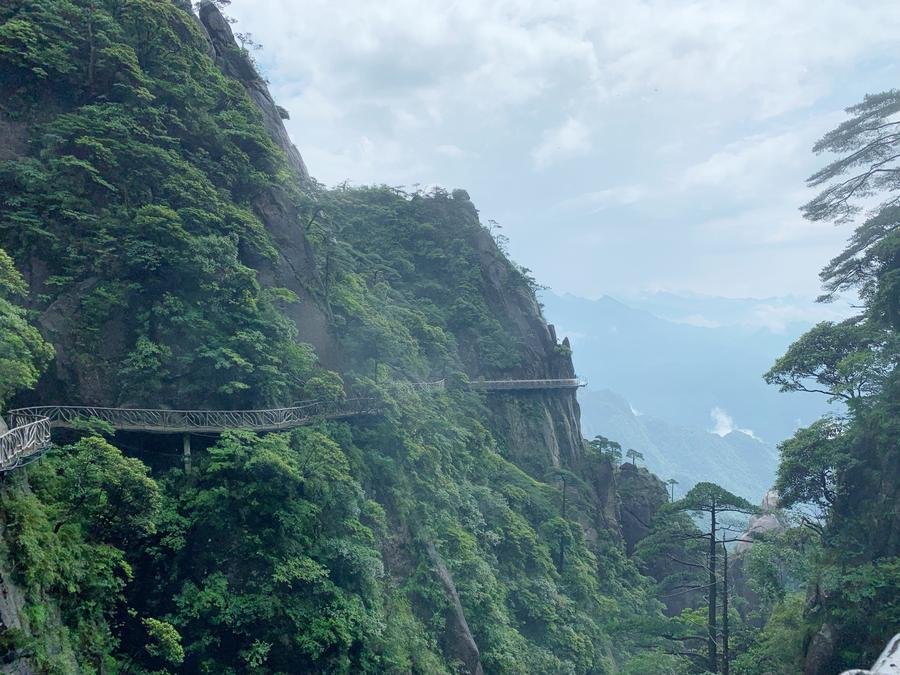
Sunshine Coast Scenic Area (阳光海岸景区)
- Location: Eastern Sanqing Mountain.
- Highlights: A newly developed high-altitude plank road area, stretching 3,600 meters. It connects the South Qing Garden to the Taoist site of Sanqing Palace, offering visitors breathtaking views of distant mountains and forests while walking among the clouds and mist.
Wan Shou Garden Scenic Area (万寿园景区)
- Location: Southern slopes of Sanqing Mountain.
- Highlights: This area is themed around longevity and fortune. The landscape includes natural rock formations and peaks that embody traditional Chinese cultural themes of health and wellness. Key spots include Pengzu’s Longevity Statue and Xianfo Peak.

Yuling Temple Scenic Area (玉灵观景区)
- Location: Below the Wind Gate, extending to Jinsha and Longquan Bridge.
- Highlights: This eastern hiking route features winding paths through lush pine and bamboo forests, offering picturesque views of mountain peaks and scenic vistas along the way.
Xihua Terrace Scenic Area (西华台景区)
- Location: Northern Sanqing Mountain.
- Highlights: Known for its ancient stone paths from the Song and Ming Dynasties, this area features poetic, pastoral landscapes reminiscent of a “peach blossom spring.” It offers lush greenery, vibrant flowers, and a cool climate even in summer.

Shigu Ridge Scenic Area (石鼓岭景区)
- Location: Eastern Sanqing Mountain.
- Highlights: Famous for its impressive waterfalls and flowing springs. Notable waterfalls include the Yulian Waterfall, one of the largest in the region, and the Shimen Fourfold Waterfall, creating a dramatic water spectacle.
Sandongkou Scenic Area (三洞口景区)
- Location: Western Sanqing Mountain.
- Highlights: This area is characterized by deep valleys and intricate gorges. It provides unique perspectives of the Yujing Peak, Penglai Immortals, and the Qiong Tai Langyuan from various vantage points, offering an unmatched exploration experience.
Major Attractions in Sanqing Mountain
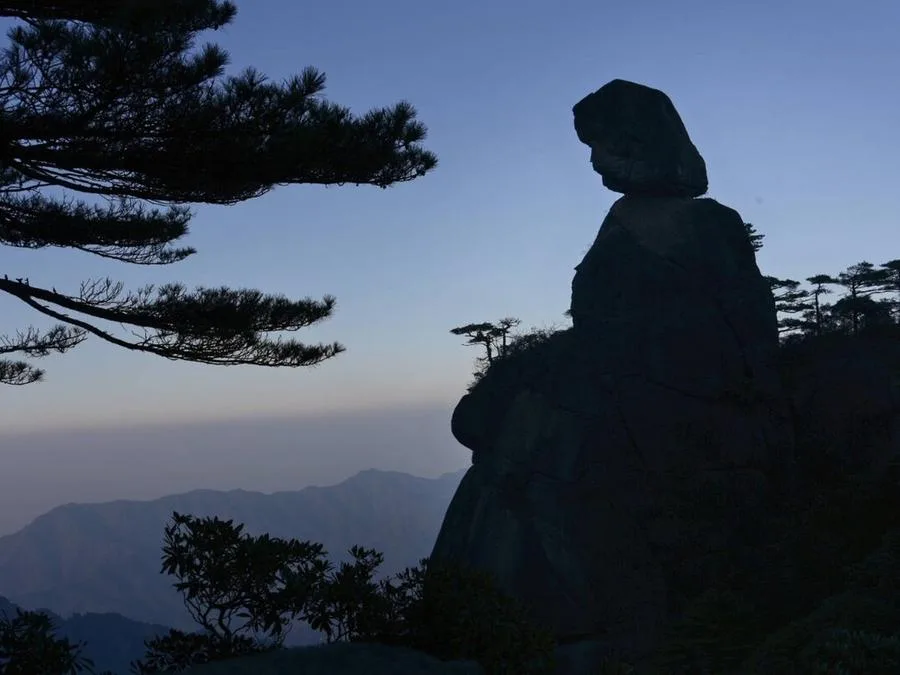
Oriental Goddess (东方女神)
- Location: Northeast of Nanqing Garden.
- Description: Standing at over 1,180 meters in altitude and 86 meters in height, this iconic landmark resembles a young maiden with flowing hair, sculpted by nature’s forces over millions of years. The goddess is believed to be Yao Ji, the twenty-third daughter of the Queen Mother of the West, and is regarded as the embodiment of spring. Her serene and majestic presence is a focal point of Sanqing Mountain.
Giant Python Emerging from the Mountain (巨蟒出山)
- Location: North of Nanqing Garden.
- Description: At over 1,200 meters in altitude, this massive granite pillar stands 128 meters high. Its flat top and slightly tapered neck give it the appearance of a gigantic python emerging from the mountain, a formation created by weathering and gravity. Despite the ravages of time, it remains a striking and enduring feature of the landscape.

Jade Maiden Opening Her Embrace (玉女开怀)
- Location: Nanqing Garden.
- Description: This attraction symbolizes the purity and beauty of Sanqing Mountain. The rugged stone peak presents a surprisingly soft and graceful form, an extraordinary natural marvel that epitomizes the mountain’s aesthetic splendor.
Monkey King Offering Treasure (猴王献宝)
- Location: Northwest of the West Sea Coast Scenic Area.
- Description: This feature depicts a giant stone figure of the Monkey King, approximately 7 meters tall, seated on a cliff and holding a treasure. The whimsical statue is both charming and emblematic, capturing the playful spirit of Sanqing Mountain’s natural artistry.
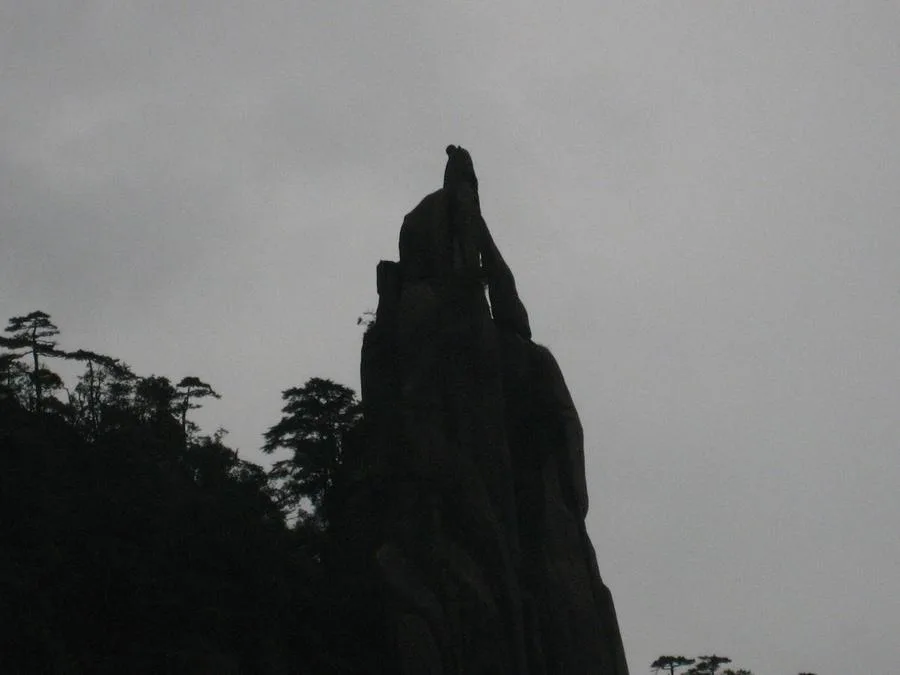
Old Taoist Bows to the Moon (老道拜月)
- Location: Within Wan Shou Garden, near the Sun Mountain Villa.
- Description: This mountain formation resembles an old Taoist priest standing in solemn reverence to the sky. The statue-like figure is particularly striking under a full moon, when it appears to offer a heartfelt bow to the moon.
Ge Hong Offering Elixirs (葛洪献丹)
- Location: Nanqing Garden Scenic Area.
- Description: Named after Ge Hong, a legendary Taoist alchemist and a revered figure in Sanqing Mountain’s history, this peak resembles a Taoist holding an alchemical gourd. Ge Hong, who traveled to Sanqing Mountain between 357 and 361 AD, is celebrated here for his contributions to Taoism and alchemy.
Spectacular Natural Phenomenon
Sea of Clouds (云海)

The Sea of Clouds is one of Sanqing Mountain’s most enchanting spectacles. It appears as a vast, ocean-like expanse of mist that blankets the landscape, creating an illusion of a sea where there is none. The sea of clouds varies with the seasons, with winter and spring offering the most dramatic views. The phenomenon is characterized by its ethereal quality – expansive yet calm, pure, and smooth. Peaks and ridges rise through the cloud cover, their forms bathed in a soft, otherworldly light. The rugged peaks of Sanqing Mountain, such as the jade-like cliffs and ancient pines, create striking contrasts against the white mist. The scenery evokes poetic imagery, with mountains appearing to merge into the sky, creating a breathtaking vista where “the thousand peaks are bathed in purple haze under the slanting sun.”
Buddha’s Light (佛光)
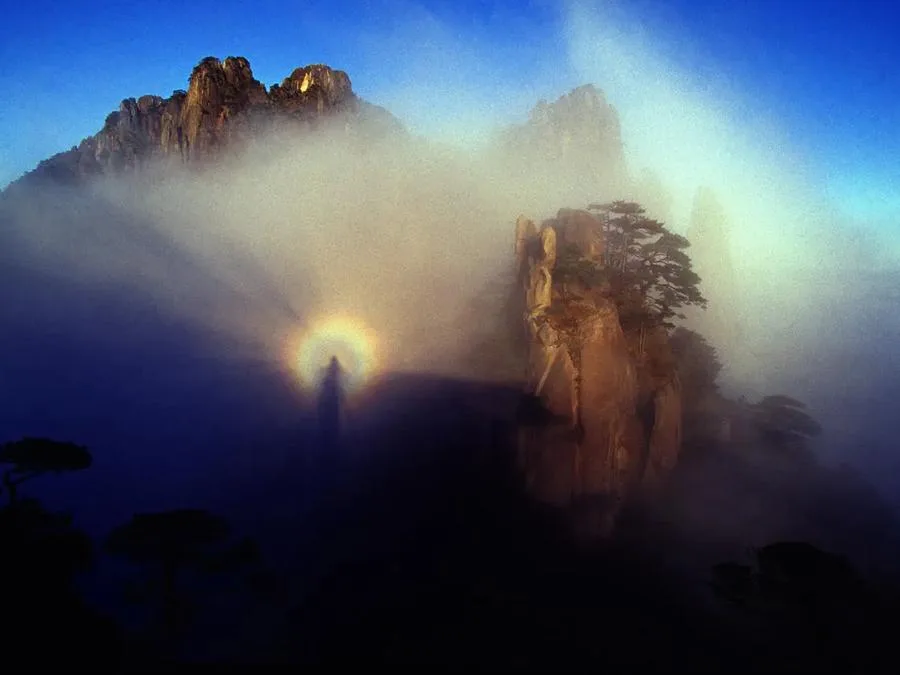
Buddha’s Light is another extraordinary natural phenomenon found in Sanqing Mountain. This optical effect occurs on clear days when the sun’s rays, filtered through mist, create colorful halos around shadows. These halos, reminiscent of rainbows, are formed when sunlight interacts with tiny water droplets in the mist. Observing from high vantage points, such as the cliffs of Shemen Cliff or the peaks of Tianmen Peak and Yujing Peak, one can see these halos encircling a person’s shadow, with the shadow perfectly centered within the halo. The halos typically display a spectrum of colors: red, orange, yellow, green, blue, indigo, and violet, creating a dazzling, multi-colored ring. This radiant phenomenon, which resembles the halo seen around Buddha statues, is thus often referred to as “Buddha’s Light.”
Cultural Relics in Sanqing Mountain
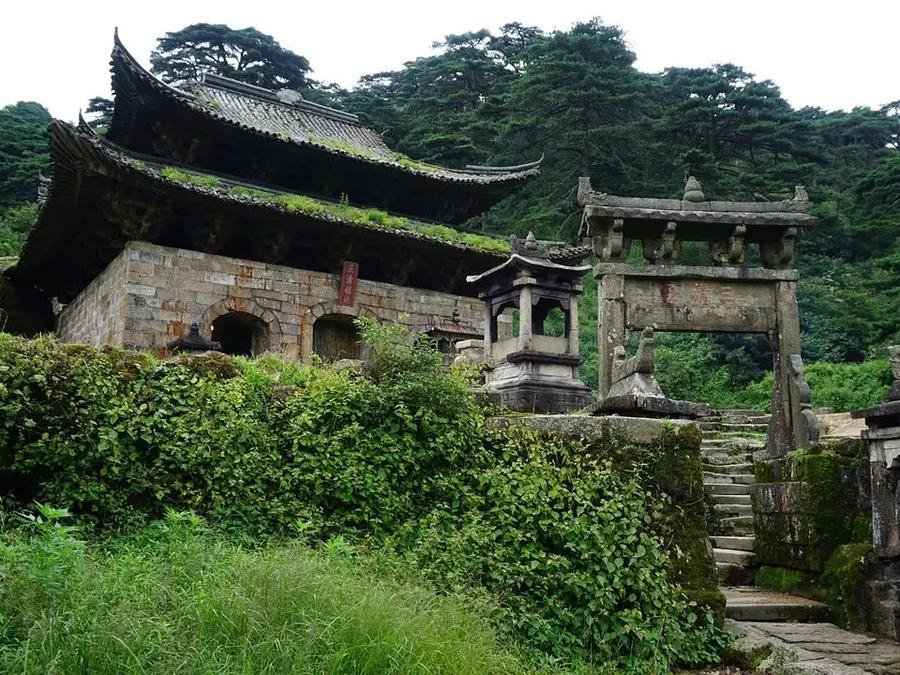
Sanqing Palace (三清宫)
- Description: Situated at an altitude of 1,460 meters, Sanqing Palace is a significant Taoist temple. It was initially established during the Eastern Jin Dynasty by Ge Hong and Li Shangshu as a place for alchemy and Taoist practices. In the Tang Dynasty, it was known as Laozi Temple, and during the Yuan Dynasty, it was renamed Sanqing Temple. The Ming Dynasty saw it expanded and renamed Sanqing Palace. The temple was destroyed by fire in 1813 and was later rebuilt by local Taoists from Yushan and Dexing counties.
Yanjiao Hall (演教殿)
- Location: On the northern side of Jiulong Mountain, in the pine forest behind the scenic area.
- Description: This hall features a granite structure with a central high hipped roof and lower side roofs. Inside, there are 18 stone carvings of deities. The entrance is inscribed with “演教殿” in classical characters.

Discipline Office (纠察府)
- Location: 150 meters northeast of Sanqing Palace, on the west side of the Chenggang area.
- Description: This structure is built from rock and features a hipped roof. The front is inscribed with “Jiucha Fu” in characters. The office contains six stone carvings of deities and is flanked by stone statues of warriors. A large rock at the back is inscribed with the characters “Teng Gang.”
Dragon and Tiger Hall (龙虎殿)
- Location: At the summit of Longshou Mountain, 1,568 meters above sea level.
- Description: This hall has an area of 46 square meters and features a courtyard layout with a hipped roof. Constructed entirely from granite, it includes stone carvings of a green dragon on the left and a white tiger on the right.
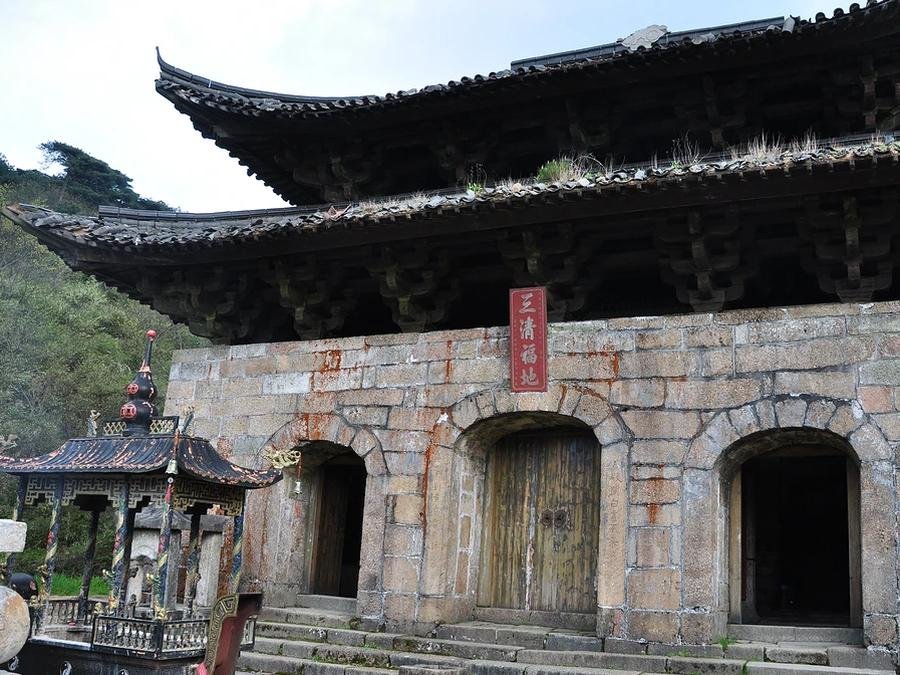
Pan Gong Temple (潘公庙)
- Location: On the peak of Linggui Mountain, 1,557 meters high.
- Description: A small, simple temple built from granite, featuring a square layout and a hipped roof. The temple is known for its unadorned, rustic style.
Jade Spirit Pavilion (玉灵观)
- Location: Northeast of the scenic area, between Longquan Bridge and Fengmen.
- Description: Originally built in the Ming Dynasty, the pavilion was destroyed by fire and later reconstructed in the Qing Dynasty, only to be destroyed again. Today, only remnants of the pavilion, such as broken pillars and inscriptions, remain.
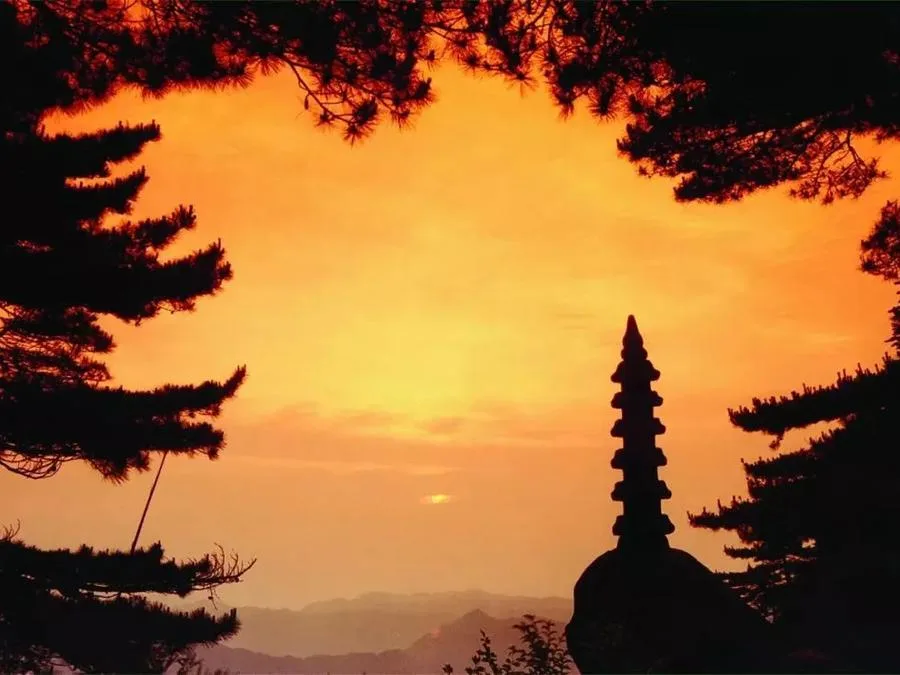
West Hua Pagoda (西华塔)
- Location: On Qingyun Ridge, between Fenshui and Fengmen.
- Description: A seven-story pagoda with a unique design, featuring both solid and hollow hexagonal eaves. It is constructed without bonding materials and stands on a tall square base. The tower’s distinctive design and rough construction make it a rare architectural example.
Wind and Thunder Pagoda (风雷塔)
- Location: Situated on a cliff between Linggui Peak and Longshou Mountain.
- Description: This five-story pagoda, made entirely from a single piece of carved stone, stands on a dramatic outcrop. Although not very tall, its elevated position gives it a commanding presence. Originally an auxiliary structure to Wang Hu’s tomb, it was constructed to avoid the winds at the mountain pass, which is why it is named “Wind and Thunder Tower.”

Step Cloud Bridge (步云桥)
- Location: At the entrance of Fenshui Village.
- Description: This ancient stone arch bridge is the first landmark for climbers ascending Sanqing Mountain. The path from the bridge leads up to Sanqing Palace, 5,200 meters away, and further to Yujing Peak, 6,900 meters away. The name “Step Cloud Bridge” reflects the ascent as it gradually rises into the clouds.
Floating Cloud Bridge (浮云桥)
- Location: On Qianbu Ridge, within the Chongxu Gate area.
- Description: A stone arch bridge situated at an altitude of 1,500 meters. It spans a deep chasm and is perched on a high cliff. The bridge’s location between Chongxu Gate to the north and Tianmen to the south adds to its dramatic and scenic appeal.
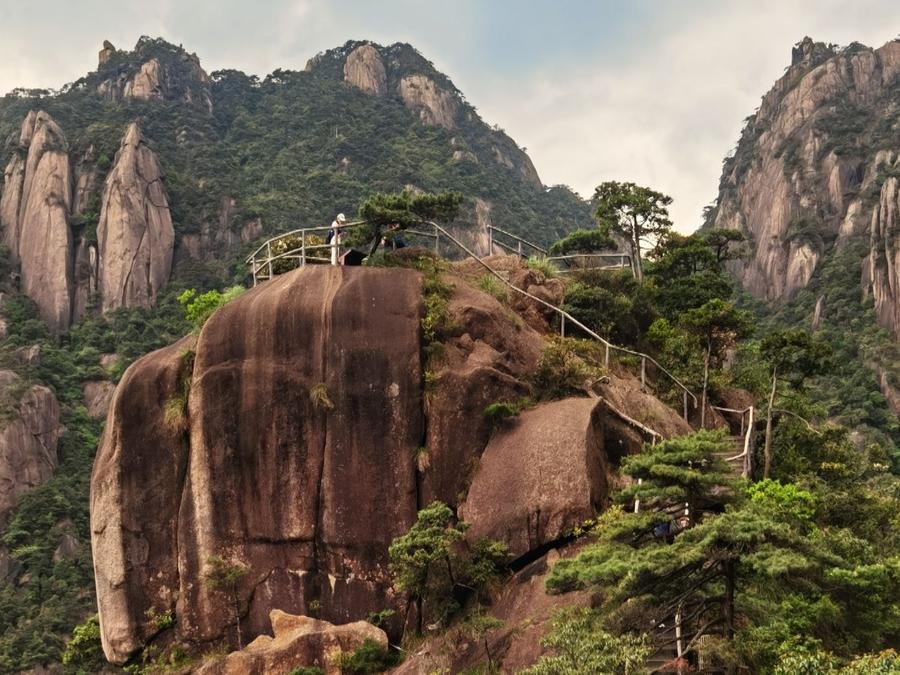
Flowing Cloud Bridge (流霞桥)
- Location: Positioned between the Jingshui Pool and Qinghua Pool.
- Description: A small, flat stone bridge that spans over the flowing streams of Jingshui Pool and Qinghua Pool, providing a serene crossing in the midst of the landscape.
Ascension Platform (登真台)
- Location: 380 meters below Yujing Peak, at an altitude of over 1,700 meters.
- Description: This platform, measuring around 20 square meters, offers a stunning view of the surrounding area. The platform features a rock with the inscription “A登真台” and has two large footprints on its southern edge, believed to be the traces of a Taoist practitioner achieving immortality.

Minister’s Enlightenment Platform (尚书悟仙台)
- Location: On the southwestern side of Yuhua Peak, at 1,700 meters above sea level.
- Description: This platform, carved from a large rock about 4 meters high, is known for its steep and challenging access. It features a weathered stone statue of a deity and an inscription “尚书悟仙台.” According to legend, Sun Yuanzhen, a Minister of the Ming Dynasty, achieved enlightenment here while observing the flowing clouds and mist below.
Immortal’s Platform (飞仙台)
- Location: On Tiger Head Mountain.
- Description: A tower-like structure with a base featuring two large square supports. The upper part has a square structure with small archways, while the top is a slightly smaller round shape with remaining archways. Though partially collapsed, its unique design and elevated position offer dramatic views of the surrounding landscape.
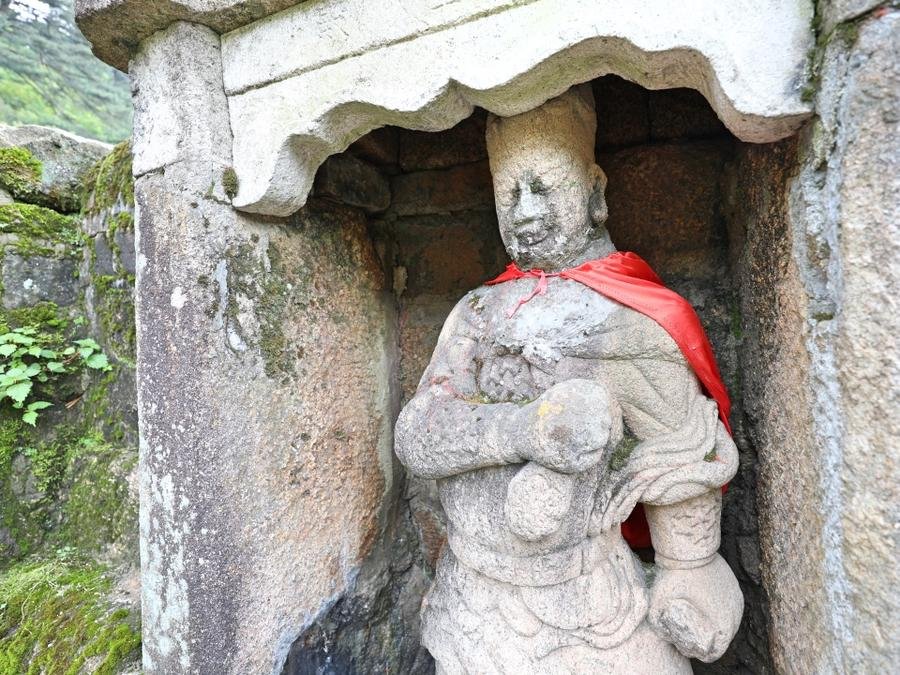
Rock Wall Sculptures (岩壁浮雕)
- Location: Along the path from Fengmen to Sanqing Palace.
- Description: The rock wall sculptures feature 24 stone figures, each approximately 1 meter tall. Most of these depict Ming Dynasty officials in traditional attire, with a serene and dignified expression, and exhibit a rugged craftsmanship. Notable sculptures include:
- Thunder God: Located on the rock wall near Yibai Steps, this sculpture depicts the Thunder God with sharp features, bare feet, armor, and weaponry, showcasing meticulous craftsmanship.
- Subduing Demon Deity: Carved into the rock wall at the northern end of Hanxing Pool’s dam, this deity wears wide robes and a Taoist headscarf, holding a jade scepter and sitting in a meditative pose.
- Dragon and Tiger Statues: Found on the large rocks flanking the entrance to Longhu Hall, the stone dragon on the left spans about 4 square meters, with prominent eyes and raised whiskers, while the stone tiger on the right, approximately 1 meter in height and width, is depicted crouching with a raised head and curved tail.
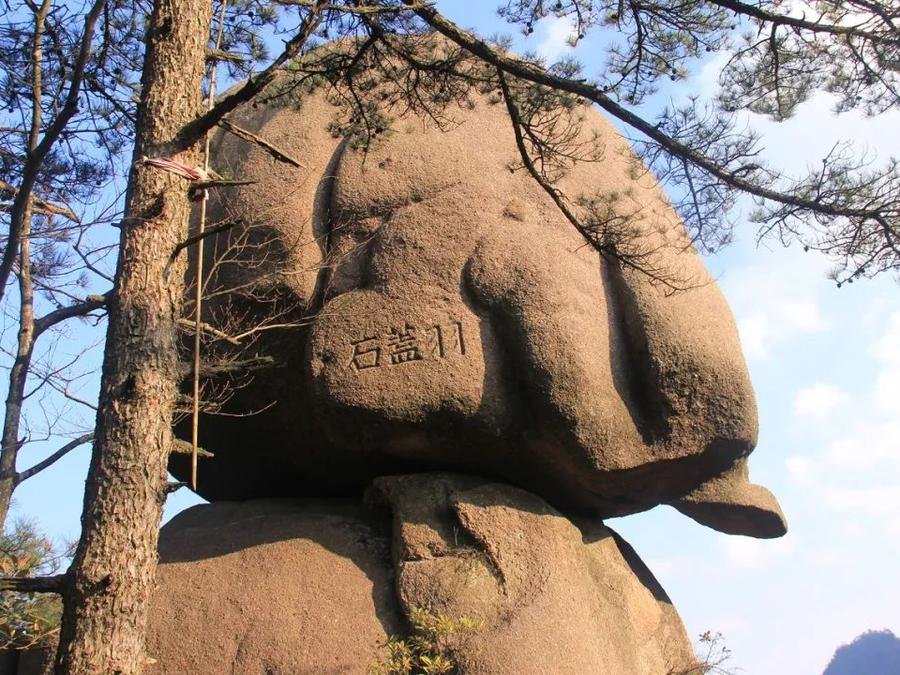
Granite Round Sculptures (花岗岩圆雕)
- Location: Various sites including Shaohua Fudi, Sanqing Palace, Yan Jiao Hall, Jiu Tian Ying Yuan, and Tianfu.
- Description: This area features over 30 stone sculptures including deities and incense burners, crafted from granite. Highlights include:
- Stone Guardians: Positioned in front of the stone archway at Shaohua Fudi and the deity shrine at Sanqing Palace, these granite guardians are over 1 meter tall with fine detailing.
- Stone Incense Burner: Standing over 1 meter high, this incense burner is adorned with beast-head patterns and is praised for its exquisite and traditional craftsmanship.
- Stone Lions: Found on the railing of the bamboo platform at Zhan Biyun’s Bamboo House, these stone lions are robustly designed with a rugged, simplistic style.
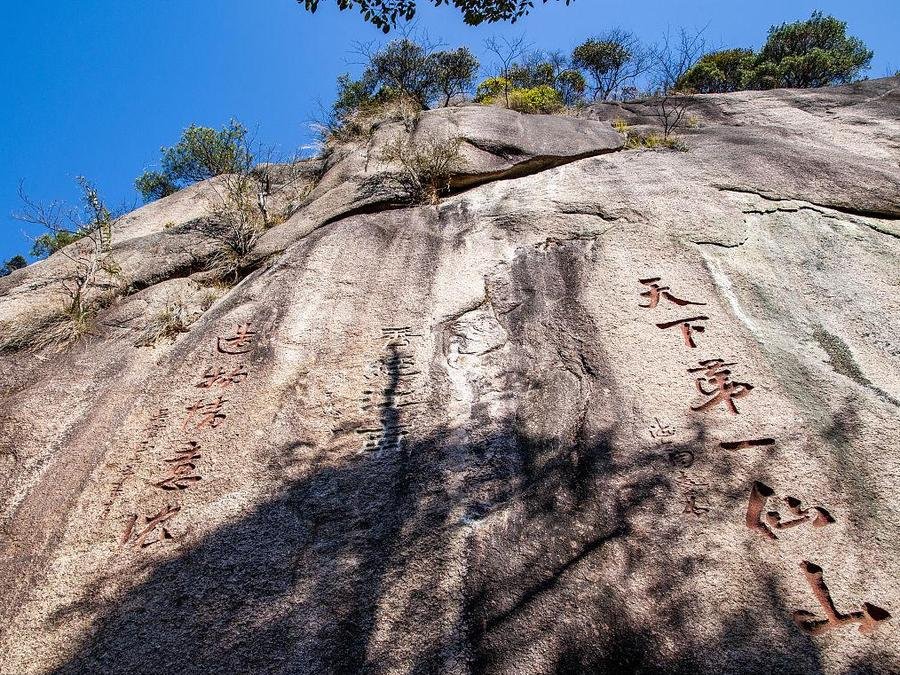
Cliff Inscriptions (峭壁字刻)
- Location: Throughout the Sanqing Mountain Scenic Area.
- Description: These inscriptions include names of peaks, scenic spots, and geographical names, with a total of 63 recorded inscriptions. Examples include:
- Peak Names: Like Baishi Well, Xianghua Cave, Wangjia Rock, Denghan Bridge, and Gua Guan Ridge.
- Artistic Style: The inscriptions are carved with a strong brushwork style, showcasing meticulous craftsmanship and conveying the essence of the characters inscribed.
Vlog about Sanqing Mountain
Sanqing Mountain and Taoism
Sanqing Mountain, known as one of China’s most revered Taoist sacred sites, has a deep and intricate connection with Taoism, reflecting its rise and fall through the centuries. This profound relationship began in the Jin Dynasty and continues to influence the region’s cultural and religious landscape.
Early Beginnings
Sanqing Mountain’s association with Taoism traces back to the Eastern Jin Dynasty (317-420), when the esteemed Taoist scholar and alchemist Ge Hong, along with Minister Li, established a hermitage on the mountain. During this period, Ge Hong, a renowned figure in Taoism and traditional Chinese medicine, chose Sanqing Mountain for his alchemical practices and philosophical writings. His presence marked the beginning of the mountain’s significance in Taoist culture. Historical records indicate that Ge Hong conducted alchemical experiments here, leaving behind relics such as the “Elixir Well” (仙井) and the remnants of his alchemical furnace. The Elixir Well, which remains a perennial source of clear and sweet water, symbolizes the enduring spiritual legacy of Ge Hong, who is often regarded as the “founding ancestor” of Sanqing Mountain’s Taoist tradition.
Flourishing in the Tang Dynasty
By the Tang Dynasty (618-907), Taoism had been officially endorsed as the state religion, leading to a period of considerable prosperity for Taoist sites, including Sanqing Mountain. In 639 AD, during the reign of Emperor Taizong, the administration reorganized local territories to strengthen its control. The establishment of Yushan County, which included Sanqing Mountain, marked the formal integration of the site into the administrative structure. This period saw the construction of the first Taoist temple on Sanqing Mountain, the Laozi Palace (老子宫观), dedicated to Laozi, a central figure in Taoist philosophy. The construction of Laozi Palace further cemented Sanqing Mountain’s role in Taoist history.
During the Northern Song Dynasty (960-1127), the emperor’s devotion to Taoism led to a proliferation of Taoist architecture on Sanqing Mountain. The construction of several Taoist temples, including the Ge Xian Temple (葛仙观), commemorated Ge Hong’s contributions. Other notable structures from this period include the Fuxing Temple (福庆观) and Lingji Temple (灵济庙). One of the most remarkable surviving relics from this era is the Fenglei Tower (风雷塔), a six-story, five-sided stone pagoda carved from natural granite. This pagoda, which has withstood centuries of weathering, stands as a testament to the grandeur of Taoist architecture during the Song Dynasty.
Yuan Dynasty Developments
Under the Yuan Dynasty (1271-1368), Taoism gained further prominence as the ruling dynasty sought to use it as a tool for consolidating control over the Han Chinese population. During this period, Sanqing Mountain attracted Taoist practitioners who were divided between different sects, including the Quanzhen (Complete Perfection) School and the Zhengyi (Orthodox Unity) School. The Quanzhen School, known for its ascetic practices, established a strong presence on the mountain, while the Zhengyi School continued to perform various rituals and ceremonies. The Yuan era also saw significant expansions in the construction of Taoist temples and structures, including the Sanqing Temple (三清观), which housed statues of various Taoist deities such as the Stone Immortal, Ge Xian, and Li Minister. Inscriptions and naming of natural features on the mountain, such as Xianren Bridge (仙人桥) and Thunder God Stone (雷公石), further reflected the era’s Taoist influence.
Ming Dynasty Prosperity
The Ming Dynasty (1368-1644) marked the zenith of Taoist activity on Sanqing Mountain. The Ming Emperor Zhu Yuanzhang’s reverence for Taoism and his appointment of Zhang Tianshi as the national Taoist leader contributed to the flourishing of Taoist practices on the mountain. With Sanqing Mountain located just 300 miles from the prominent Taoist center of Longhu Mountain, there was a vibrant exchange of Taoist teachings and practices between the two sites.
During this period, Sanqing Mountain saw the construction of numerous Taoist buildings and structures, including the Longhu Hall (龙虎殿), the Fenglei Tower (风雷塔), and the Yuling Temple (玉零观). The architectural style of these buildings was unique, featuring granite stonework, intricately carved stone statues, and detailed inscriptions. The Ming Dynasty also witnessed the rise of grand pilgrimage events, with thousands of Taoist practitioners and devotees participating in annual ceremonies and festivals, such as the “Yearly Pilgrimage to Sanqing” (一年朝三清) and “Yearly Pilgrimage to Shaohua” (一年朝少华). These gatherings, characterized by processions with incense, offerings, and musical performances, underscored the mountain’s central role in Taoist religious life.
Modern Era and Legacy
The Qing Dynasty (1644-1912) and subsequent periods saw varying degrees of support and neglect for Taoism, influenced by broader political and social changes. Despite these fluctuations, Sanqing Mountain continued to be a significant Taoist site, attracting scholars, practitioners, and tourists. In contemporary times, the mountain remains a major destination for those interested in Taoist culture and history.

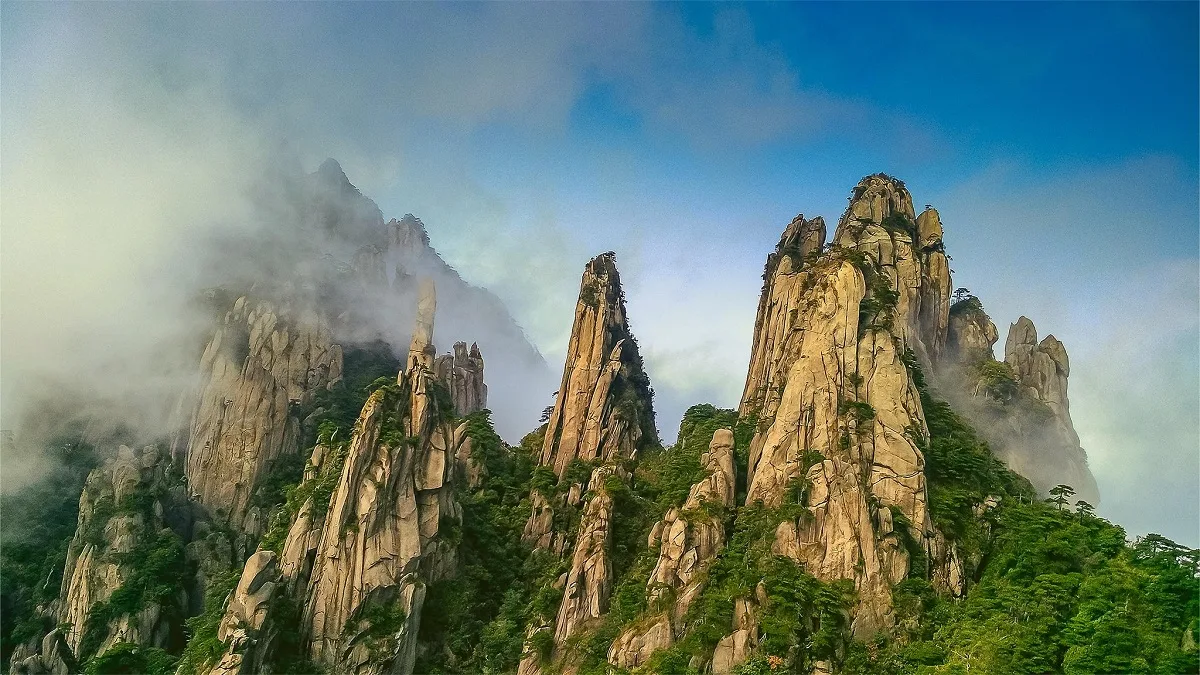



Sanqing Mountain is truly beautiful! It feels comparable to Huangshan Mountain. When I ascended the mountain, I encountered unpredictable weather following a few days of heavy rain, which resulted in a stunning yet ever-changing landscape. However, it was really cold; I didn’t wear enough layers on my way up and was shivering from the chill.
Hiking for 7 hours covering 18 kilometers to complete the Grand Loop of Sanqing Mountain is an unforgettable experience. The breathtaking beauty of Sanqing Mountain can only be truly appreciated in person.
Sanqing Mountain is incredibly beautiful; I couldn’t capture its true appearance in my photos at all. Today, I set off from Shangrao to Shuangwaixi at Sanqing Mountain around noon, which took about an hour and a half. We arrived at Shuangwaixi around 2 PM and smoothly entered the mountain without any queues. After taking the cable car down, I walked a few steps to check in at Tianmen Mountain Villa. After dropping off my things, I started my itinerary around… Read more »
Today, there was heavy fog at Sanqing Mountain. There were few people taking the Outer Double Creek Cable Car (外双溪索道), so there was no need to queue. The climb up to Dujuan Valley was steep. I rented a tent to stay overnight, hoping for a clear day tomorrow. For those with good stamina, I recommend taking the Outer Double Creek Cable Car, as it involves more uphill walking. For those who may not be as fit, the Jinsha Cable Car… Read more »
January 13th – January 19th
Weather: Mostly sunny throughout the week, with low humidity. Great visibility of the mountains. Perfect for observing sunrises, sunsets, and the starry sky.
The sunrise viewpoint can be found at Yutai .
The sunset viewpoint is also at Yutai.
The stargazing point is in front of the Goddess Hotel.
I recommend staying overnight on the mountain to see the sunrise, sunset, and star-filled sky.
The cable car ride took quite a long time. We took the smaller circuit, which is basically a loop around the mountain. Halfway through, we stopped to look at the Giant Python and the Goddess. After viewing them, I didn’t want to keep walking, so we took the left path downwards. The cable car took us down after that. We spent exactly 3 hours on the small loop. The medium loop continues upward from there. Personaly, This mountain doesn’t have… Read more »